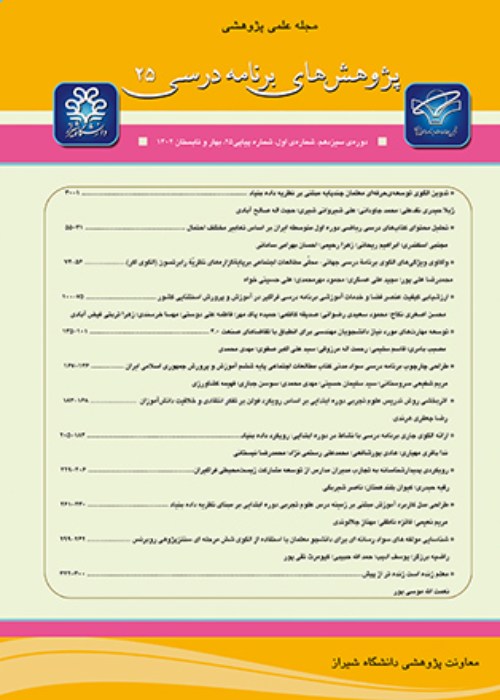An Analysis of Iranian Junior High School Mathematics Textbooks Based on Different Interpretations of Probability
Today, the concept of probability is not only used in different fields of science and daily life but also included in the school curricula of various countries, including Iran. However, teaching and learning the concept of probability is fraught with challenges, of which some are unique to probability itself such as the multifaceted nature of probability, which lends itself to different interpretations and meanings. Currently, the three basic interpretations of probability included in the school mathematics curriculum are classical, frequentist, and subjective interpretations. Despite the continued attention paid to different interpretations of probability in different studies worldwide, few studies have focused on this issue within the context of Iranian school curriculum. Therefore, considering the importance of textbooks in the Iranian centralized education system and the need to deal with different interpretations of probability in these books, this research aimed to analyze national mathematics textbooks taught in junior high schools in Iran based on classical, frequentist, and subjective interpretations of probability. The results are hoped to shed light on how much attention is given to each of the three aforementioned approaches in the mentioned textbooks.
Research Questions:
The research questions were as follows:1- How and to what extent is each of the classical, frequentist, and subjective interpretations of probability addressed in the seventh-grade high school math textbook?
2- How and to what extent is each of the classical, frequentist, and subjective interpretations of probability addressed in the eighth-grade high school math textbook?
3- How and to what extent is each of the classical, frequentist, and subjective interpretations of probability addressed in the ninth-grade high school math textbook?
4- How and to what extent do the mathematics textbooks designed to be taught in Iranian junior high schools deal with each of the classical, frequentist, and subjective interpretations of probability as well as the interaction between them?
This applied research utilized a quantitative approach. The data were analyzed through content analysis. The statistical population included seventh-, eighth-, and ninth-grade math textbooks (2021 edition), and the sample was selected purposefully and proportionately to the statistical population. A researcher-developed rubric was used to analyze the content of selected textbooks regarding the three interpretations of probability. The content and face validity of the research tool were confirmed by the authors of mathematics textbooks and several university faculty members in the fields of mathematics, statistics, and curriculum planning. To ensure the reliability of coding, the degree of agreement between the coders was assessed, and the results showed high a level of intercoder agreement.
The findings showed that 76% of the tasks in the probability section of mathematics textbooks taught in junior high schools were designed according to the classical interpretation, and the other two interpretations accounted for only 24% of the tasks, of which only 5% were related to the frequentist interpretation. This scant attention paid to the frequentist interpretation does not seem to be sufficient compared to the dominant presence of classical interpretation used in mathematical tasks. Additional analysis of the data showed that in the three above-mentioned books, only one task was designed with the aim of communicating the definition of probability.
Based on the findings, it was found that more than three-quarters of the tasks pertinent to the concept of probability in junior high school mathematics textbooks were designed according to the classical interpretation. The other two interpretations, namely, frequentist and subjective, were utilized in less than a quarter of all tasks. These results are in line with those reported by Gandhi (2022) in India and Martin et al. (2022) in Canada.
In explaining the results of this study, it can be said that no reliable scientific research has been done in Iran to introduce and examine different approaches and interpretations of probability and the relationship between them. Therefore, it can be concluded that the lack of in-depth research is one of the main reasons that has caused the imbalance in the presentation of different interpretations of probability in Iranian mathematics textbooks in junior high schools. Another main reason that can be cited for the above results is that content standards related to mathematical concepts, including probability, are not met in Iran. Accordingly, it is suggested that the authors of mathematics textbooks in Iran introduce all three interpretations of probability to students and ensure that all these three interpretations are reflected equally in tasks. Moreover, mathematics textbook writers are recommended to explain not only the importance and application of these approaches to probability but also how they are connected with each other. This is a crucial point because when students reach the next stages of their academic lives, i.e., senior high schools and university, the importance and application of frequentist and subjective interpretations increase in some cases. Finally, due to the fact that only few studies have been conducted on the concept of probability in Iran, it is suggested that more studies focus on how different approaches to and practical uses of probability can be included in high school mathematics textbooks.
- حق عضویت دریافتی صرف حمایت از نشریات عضو و نگهداری، تکمیل و توسعه مگیران میشود.
- پرداخت حق اشتراک و دانلود مقالات اجازه بازنشر آن در سایر رسانههای چاپی و دیجیتال را به کاربر نمیدهد.





